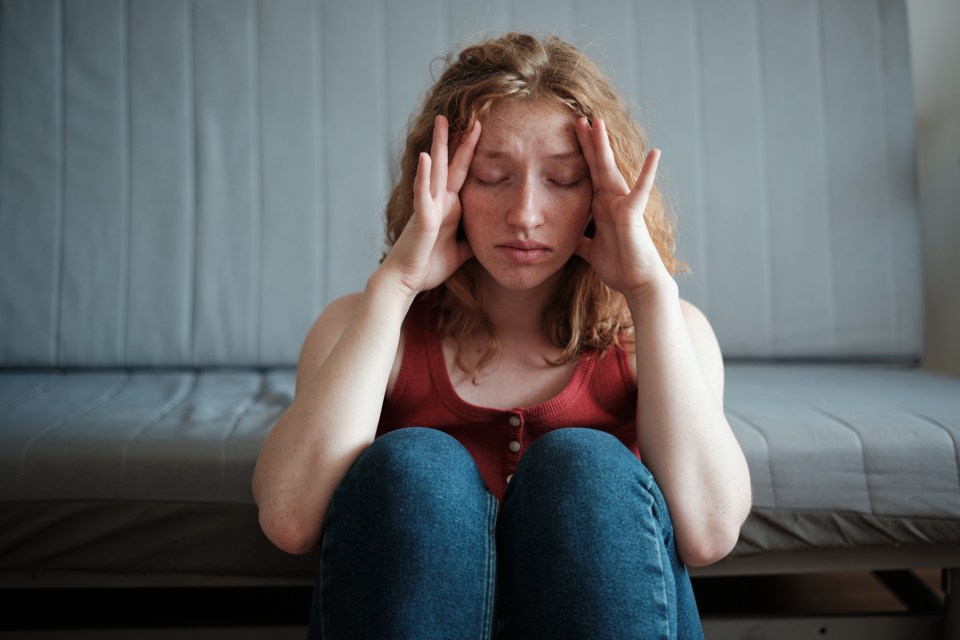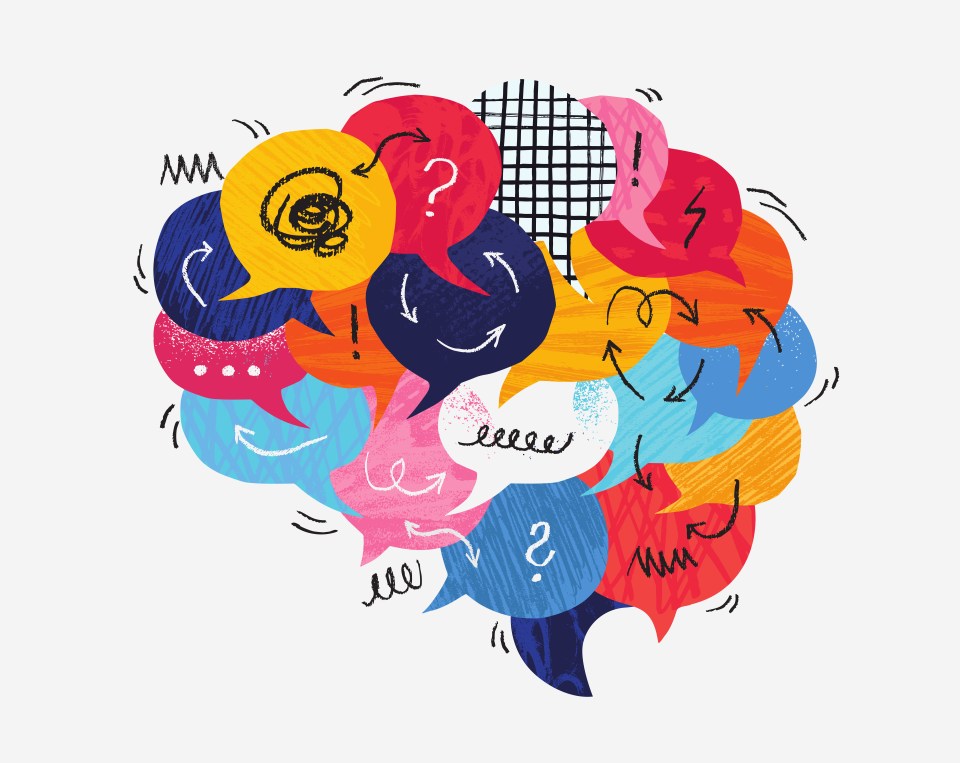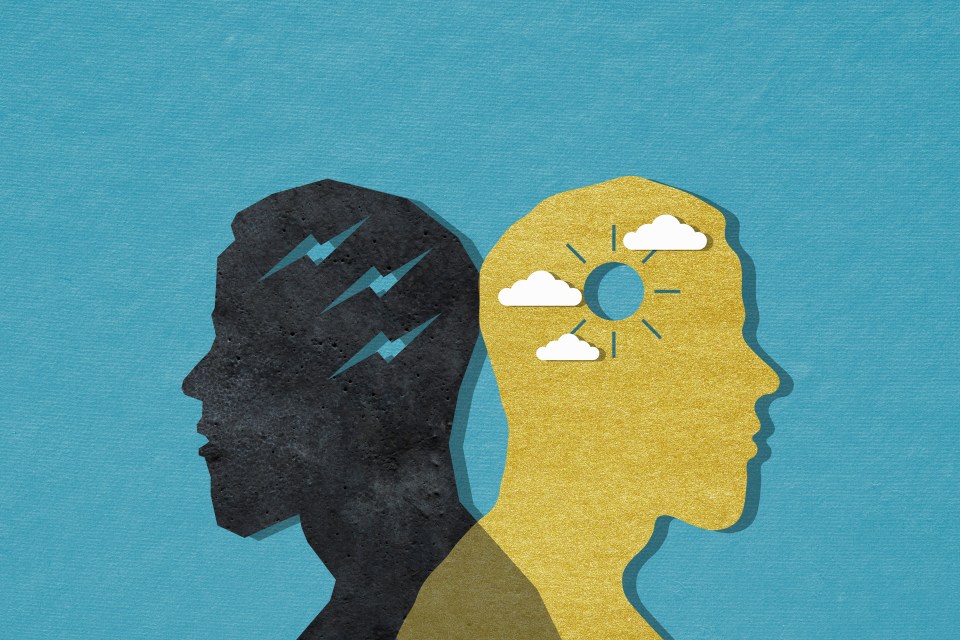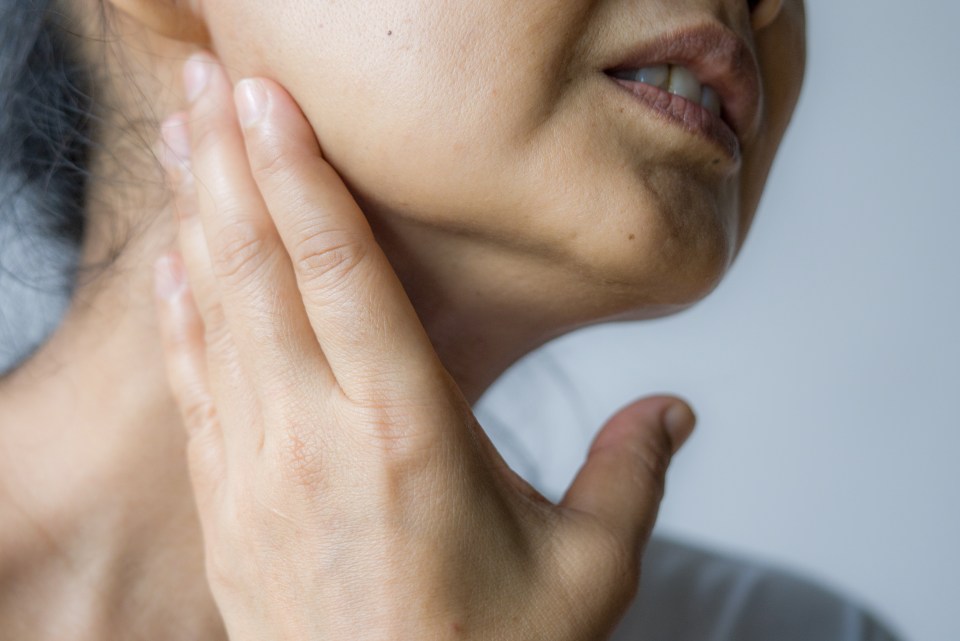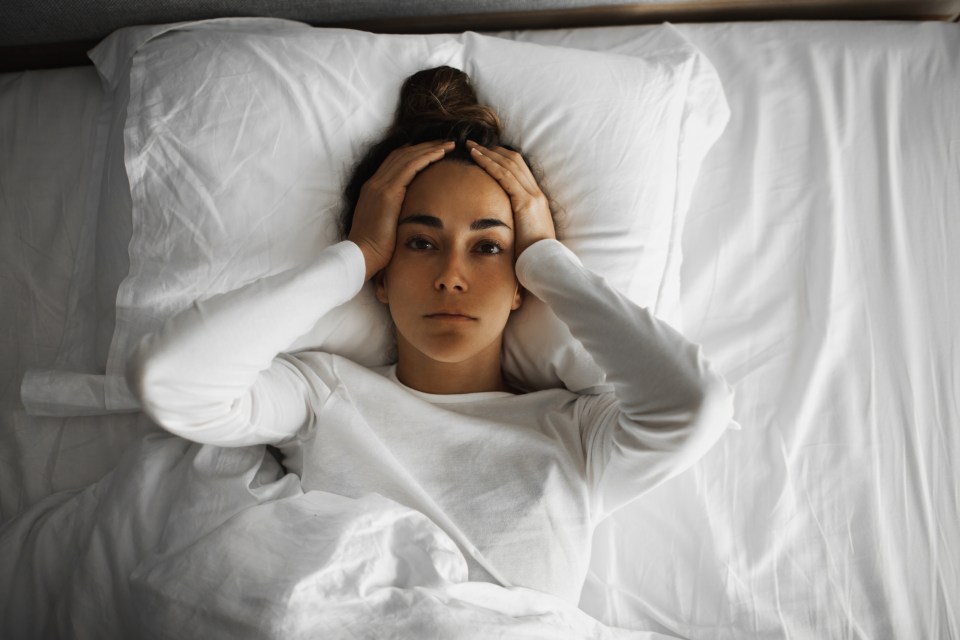WHETHER it’s an important work presentation, an overcrowded train or a first date – we all get anxious.
It’s very normal, especially in nerve-wracking situations like these!
But if your anxiety is persistent, excessive and interferes with daily life, it might be more than just “everyday worries”.
Here’s how to tell when your anxiety has slipped into a disorder and might require professional help…
WHAT IS ANXIETY?
“ANXIETY is the body’s alarm system being stuck in the ‘on’ position – without a clear, present danger,” Clare Patterson, a therapist registered with the British Association for Counselling and Psychotherapy (BACP), tells Sun Health.
“It is different from fear, which is a natural human response and arises as a helpful signal to the body that something needs our attention.
“When we perceive danger, the hypothalamus in the brain signals to the adrenal glands (above the kidneys) to release stress hormones – cortisol and adrenaline.
“This is part of the HPA axis (hypothalamic-pituitary-adrenal axis), which is the body’s central stress response system.
“Once the situation is dealt with or passes, the system returns to baseline.
“What can sometimes happen though, through exposure to chronic stress or trauma (particularly in early life), is that the system gets ‘stuck’.” Here’s how:
- Overactivation of HPA axis – if the brain continues to perceive a threat (whether real or imagined) the hypothalamus continues to signal to the adrenal glands to produce cortisol.
- Cortisol flooding – high levels of cortisol over time begin to desensitise cortisol receptors in the brain, especially in the hippocampus (which helps regulate the HPA axis) and prefrontal cortex (which helps with rational thinking and emotional regulation).
- Loss of feedback loop – this feedback mechanism, where cortisol is supposed to shut down the stress response, gets impaired, so the system doesn’t know how to switch off. The body stays in a state of hypervigilance.
“As a result, the nervous system remains on high alert, even in the absence of real danger,” Clare adds.
“The body reacts as if a threat is always imminent.
“Triggers (even minor ones) can feel overwhelming. This can manifest as panic, intrusive thoughts, physical tension, and chronic worry, and this is what we might call ‘anxiety’.”
THE DIFFERENCE BETWEEN ‘REGULAR’ ANXIETY AND AN ANXIETY DISORDER
‘REGULAR’ anxiety tends to be situational.
“You might feel anxious before getting medical test results, or before a job interview,” Clare says.
“But once the perceived threat has passed, the symptoms subside.
“It’s only when anxiety becomes chronic, disproportionate and disabling – when it is no longer just a signal but the environment you’re living in – that it may be said to be disordered.”
There are seven types of anxiety disorder recognised by the Diagnostic and Statistical Manual of Mental Disorders (DSM).
These are:
- Generalised anxiety disorder (GAD) – excessive worry about various aspects of life, most days for at least six months, accompanied by symptoms like restlessness, fatigue, difficulty concentrating, irritability, muscle tension, and sleep disturbance.
- Panic disorder – recurrent, unexpected panic attacks followed by at least one month of worry about future attacks or behaviour changes to avoid them.
- Social anxiety disorder – marked fear or anxiety in social situations where the person may be scrutinised.
- Specific phobia – intense fear or anxiety about a specific object or situation (e.g. flying, heights, animals), which is out of proportion to the actual danger.
- Agoraphobia – fear of being in places where escape might be hard or help unavailable in the event of panic-like symptoms.
- Separation anxiety disorder – excessive fear or anxiety about separation from attachment figures.
- Selective mutism – consistent failure to speak in certain social situations despite speaking in others which interferes with functioning and is not due to language or communication disorders.
So how do you tell if you’ve got one of these disorders?
1. NO COPING MECHANISMS
CLARE says: “A person with ‘regular’ anxiety may be somewhat nervous to walk into a party full of strangers, but has the ability to self-regulate, and so takes steps to make themselves feel safe.
“These might include things like positive self-talk, seeking out a familiar face, or deep breathing and body awareness to help ground themselves and manage their anxiety.”
Someone with a disorder may not have these healthy coping mechanisms.
“The rational part of their brain may be overwhelmed by the anxiety and so they exist in a fight/flight/freeze state where there is a lack of trust in themselves to cope and manage,” Clare adds.
“This can trigger even more anxiety, sending them into a spiral, and even lead to physical symptoms including panic attacks, headaches and dizziness.
“They may ‘get through’ the event, not really being present for it, relying on old survival wiring, rather than learning that they can cope, and so developing resilience and confidence for next time a similar event occurs.”
2. CATASTROPHISING
DO you worry excessively about future problems or what could go wrong? This is another sign of an anxiety disorder.
Clare says: “You might lie awake at 2am thinking, ‘What if I lose my job? What if I can’t pay the mortgage? What if I end up homeless?’, even when nothing has changed at work.
“You may also catastrophise, always assuming the worst-case scenario.
“For example, your partner doesn’t reply to a message for a few hours and your brain jumps to, ‘They’re in a crash’ or ‘They’re leaving me’.”
This doom-mongering can significantly interfere with day-to-day life.
“You might be trying to focus at work but your mind is pinging from, ‘I forgot to book the dentist’ to ‘Do I have cancer?’ to ‘I should drink more water’, all in 30 seconds,” Clare says.
“You may also be in a meeting and notice every change in someone’s tone, face or body language, and be convinced it means something bad about you.”
3. INDECISIVENESS
BECAUSE anxiety affects someone’s mental and emotional wellbeing, it can cause constant self-doubt.
“This often leads a person to second guess even small decisions, like what to wear or what to say in a text,” Clare says.
“They might also spend 15 minutes staring at a restaurant menu and still feel afraid of ordering the ‘wrong’ thing.”
4. CONSTANTLY OVERWHELMED
“SOMEONE with disordered anxiety may find everything overwhelming,” Clare says.
“For example, a relationship breakup might be overwhelmingly distressing, leaving them to assume they will be unable to cope without their significant other.
“They may be unable to eat, sleep or care for themselves at the prospect of such a loss.
“Someone with ‘regular’ anxiety will of course find such an event distressing too, but they have much more ability to take a step back from their anxiety and look at things practically.
You might not be able to sit still watching TV so you keep checking your phone, pacing, or jumping up for no reason
Clare Patterson
“They may seek support from friends and relatives as well as engage in self-care activities to help calm the nervous system and prevent the symptoms of anxiety from becoming overwhelming.
“As their system is not stuck in the ‘fight/flight/freeze’ response, they have much better access to the parts of their brain responsible for making rational decisions.”
Clare adds: “For people with an anxiety disorder, the excessive stress hormones can feel overwhelming and effectively shut down these higher executive functions.
“It is not ‘all in their heads’. It is a very real, physiological response.”
5. WITHDRAWAL
SOCIAL situations can be anxiety-inducing for many of us.
But it could be classed as a disorder if it starts to change your behaviour.
“It can make people withdraw, avoiding parties, dates or even not replying to texts because of fear or overwhelm,” Clare says.
“Cancelling plans, staying home or isolating – even when you feel lonely – is common because social interaction can just feel too intense.”
6. EMOTIONS ALL OVER THE PLACE
MANY people with anxiety report feeling restless, agitated or ‘on edge’.
“You might not be able to sit still watching TV so you keep checking your phone, pacing, or jumping up for no reason,” Clare says.
But it’s not all about being unable to relax. Anxiety can play with your emotions in other ways, like making you more irritated, fearful or guilty than usual.
“Snapping at your partner because they asked what’s for dinner, even if you know it wasn’t a big deal, is a common example,” Clare says.
“A low-level fear with no clear object, like waking up with a pit in your stomach for no reason, just a vague feeling something is going to go wrong today, is also common.
“Some people also find their anxiety is internalised and they keep thinking, ‘What is wrong with me?’
“You might cancel plans because you’re feeling overwhelmed, then spend hours criticising yourself for being ‘flaky’ or ‘too sensitive’.”
Do you have anxiety?
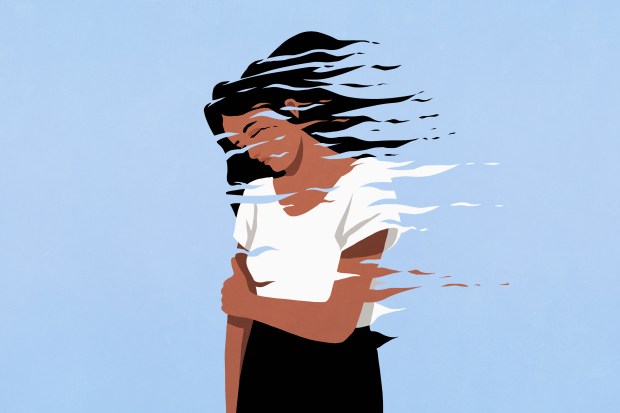
AROUND one in six adults in the UK experience some form of anxiety disorder each week.
Globally, anxiety disorders affect more than 300million people, making it one of the most common mental health conditions in the world.
Post-pandemic levels are even higher, especially among young adults and women.
Anxiety can affect anyone, but it’s more common in certain groups:
- Women are twice as likely as men to be diagnosed with an anxiety disorder, which may be due to hormonal factors, social roles and higher rates of trauma.
- Young adults and teens, which may be due to social pressures, academic expectations, uncertainty about the future.
- People with a family history of anxiety – genetics can play a role but so can learned behaviours or anxious environments.
- Highly sensitive or empathic people – people who are deeply attuned to others’ feelings may absorb more stress.
- Those with long-term stress or trauma – childhood emotional neglect, abuse or high-pressure environments can prime the nervous system for hypervigilance.
- LGBTQ+ communities – due to stigma, discrimination and social exclusion.
Anxiety is usually diagnosed through a clinical interview with a GP, psychologist or psychiatrist, who will ask about symptoms, duration and how they’re impacting your life.
There are screening tools such as the GAD-7 (generalised anxiety disorder 7-item scale) which can help assess severity and track changes over time.
Possible symptoms include:
- Physical: faster heartbeat, dizziness, headaches, chest pains, loss of appetite, sweating, feeling hot, shaking, breathlessness.
- Mental: feeling tense or nervous, being unable to relax, worrying about the past or future, feeling tearful, sleep problems, difficulty concentrating.
- Behavioural: not enjoying leisure time, difficulty looking after yourself, struggling to form or maintain relationships, worried about trying new things, avoiding places and situations that create anxiety.
Speaking with a GP can rule out physical causes (such as thyroid issues), and discuss medication (e.g. SSRIs for moderate to severe anxiety). You may also be referred to talking therapy, like CBT (cognitive behavioural therapy).
You can also find your own therapist via the BACP or The Counselling Directory.
This guilt can also extend to others.
“If your friend seems sad, you assume it must be something you did – even if they say otherwise,” Clare adds.
But anxiety can sometimes cause emotional numbness, where you feel very little at all, and perhaps even fear positive emotions.
“Some people feel ‘shut down’ or flat, like they ‘should’ feel something but don’t,” Clare says. “This often masks chronic anxiety.
“You might also feel uneasy or suspicious when things are going well, waiting for the ‘others shoe to drop’.”
7. TENSE ALL THE TIME
TIGHTNESS in your chest, headaches, jaw pain, back niggles and being unable to relax in bed – these are all signs your anxiety is causing tension.
And sometimes this tension simply won’t go away. That’s when it might be disordered.
Clare says: “Anxiety isn’t just a mental response – it’s a whole-body experience that can involve a racing heart, nausea, dizziness, muscle pain, insomnia, digestive issues and chronic tension.
“The idea that it’s just in someone’s head can make people believe they’re overreacting or being silly, when in reality their distress is very real and valid.”
8. PERFECTIONISM
AROUND 85 per cent of people consider themselves to have some perfectionist traits, so striving for flawlessness and setting unrealistic standards is pretty common.
But in some people, it can signal an anxiety disorder.
“Anxiety can lead to perfectionism and procrastination, putting off work because it’s never quite good enough,” Clare says.
If it causes significant distress or impairment, it is time to seek help.
Clare says: “If anxiety is interfering with a person’s day-to-day functioning, it is important to seek treatment.
“It may be that the body’s natural stress response has become dysregulated, and this can take time to resolve and re-regulate.
“For many people, this was established in early childhood. Home and school environments were not always predictable, and any unresolved trauma may have led to a ‘freeze’ state which can take time to ease and resolve.
“Talking therapies can be very helpful. Many people absorb the message that there was something wrong with them, meaning the stories the mind tells in times of threat are ones of mistrust or fear.
“Low self-esteem can make it so that people underestimate their ability to deal with real or imagined danger.
“Therapy can help understand what dynamics might have led someone to feel a lack of trust in themselves, and help them build a more accurate self-view and healthier coping strategies.”
Medication can also help some people. This is usually a type of antidepressant called an SSRI.
Speak to your GP about what might work best for you.
How to beat anxiety
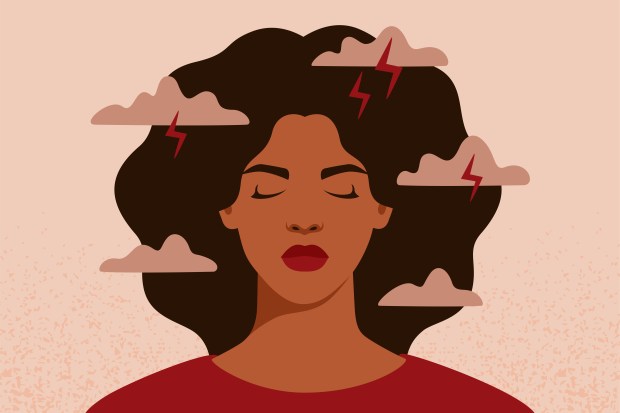
By Susan Griffin, Features Writer
1. Stop thoughts spiralling
The first step is understanding and acknowledging what is happening when you begin to feel anxious – your body is going into protective mode.
The second step is to focus on the facts, rather than letting your imagination run wild.
“So, when you start panicking, instead of thinking: ‘My body is falling apart and something terrible is going on,’ think: ‘My heart is racing and that is my healthy heart responding to adrenaline, because I’m anxious about such and such’,” says NHS GP Dr Martin Brunet,
“It is about taking a step back, allowing the adrenalin in your body to drop a little bit and your breath to slow down, so you are not spiralling.”
2. Rethink your language
Your language reflects your mindset, and therefore, adapting it can prove empowering.
Someone stuck in “obey mode” to their anxiety often tells themselves “I can’t” or “I have to” statements.
Dr Brunet explains: “It restricts their life, leaving them powerless.”
Reframing your anxiety as a doubting disorder, for example, can be useful.
“Anxiety is best thought of as a problem with uncertainty or doubt,” says Dr Brunet.
You might remind yourself: “I find it difficult to deal with uncertainty and doubt.”
He adds: “You’re acknowledging it’s not what you want, and it’s a challenge for you, but notably, you can work with that and move forwards.”
3. Expand your comfort zone
Anxiety can be all-consuming, so Dr Brunet suggests approaching recovery like rehabilitation of a physical injury – slowly and kindly.
He recommends drawing three large circles, one inside the other. The inner circle is the Comfort Zone.
He says: “Write down activities where anxiety might not be absent, but you do them freely because you enjoy them.”
The outer circle is the No-Go Zone: “Write down activities or situations anxiety currently stops you from doing, but you would be happy to never do. It reminds us that anxiety is normal.” This could include getting public transport, for example.
The middle circle is the Expansion Zone: “Write down activities or situations you can’t do because of your anxiety, but would like to do.” For example, you would like to go to your friend’s party, despite knowing few people.
Work on expanding your Comfort Zone.
“Pick something you think you can realistically achieve and plan how you might start doing that thing in little steps,” says Dr Brunet.
“It might be going that bit further or doing something a bit longer each time, and then practise getting used to each step, tolerating and accepting the feeling of anxiety that you get when you do it.”
4. Imagine your anxiety monster
It might sound absurd to put yourself in situations where you have to endure anxiety.
So, imagine your anxiety as a goofy monster or an excitable puppy, and give it a name you find funny – in his book, Dr Brunet calls it Wilbur.
“You can’t expect Wilbur to stay at home, so you acknowledge he will be with you as you go about your day,” he says.
“You’re not going to fight him; you’re not going to let him be the boss. You might even thank him for trying to keep you safe, but reassure him everything is OK. That way, he quietens down.”
If this feels daft, it should do!
“Anxiety takes itself very seriously and there is power in the silliness,” says Dr Brunet.
“So, if thinking of your anxiety monster makes you smile, you are building new associations in the brain and changing your relationship with anxiety.”


